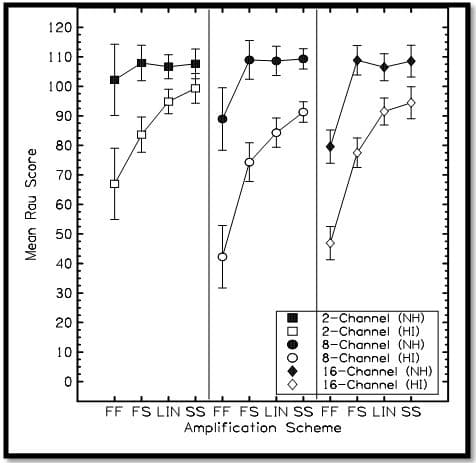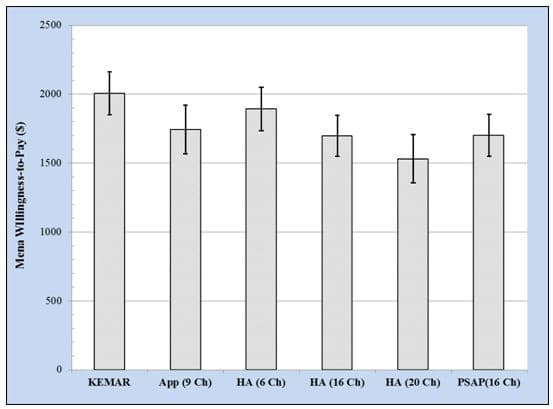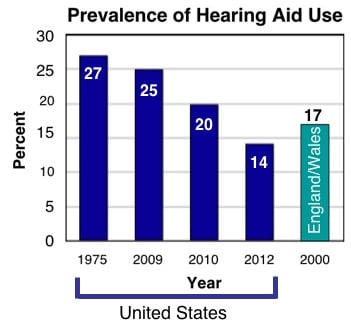Pricing hearing aids by the number of channels is a common but flawed strategy, based on the erroneous assumption that increasing the number of channels will consistently provide listeners with improved aided performance.
Speech-recognition performance does not always improve as a function of number of channels, as discussed in part 1. In part 2 Amyn Amlani, PhD, presents behavioral, and psychological evidence of potential diminished listening performance as a function of number of channels.
Behavioral Performance
Each phoneme has a characteristic shape (i.e., speech envelope), and the spectral contrast of the speech envelope is an acoustic cue used by listeners to discriminate among phonemes. Both Bor et al (2008)1,2 evaluated the ability of listeners with reduced hearing sensitivity to discriminate vowels in a /CVC/ syllable as the number of channels increased. Results revealed that as the number of channels increased, listeners experienced greater difficulty in discriminating among vowels.
In addition, Amlani and colleagues in their 2011 article also assessed the influence of changes to the WDRC attack and release time characteristics. Specifically, three variations of WDRC were evaluated:
- fast-fast (attack time [TA] = 1 msec; release time [TR] = 25 msec)
- fast-slow (TA = 1 msec; TR = 1500 msec)
- slow-slow fast-slow (TA = 100 msec; TR = 1500 msec).
Results revealed that vowel-identification was reduced most in the fast-fast scheme, followed by fast-slow, and slow-slow. This latter finding suggests that when a large number of channels are used, the spectral contrast can be better preserved by increasing the attack and release times to preserve the speech envelope.
Since conversation occurs as a series of syllables, as opposed to isolated syllables, Amlani et al (2013)3 undertook a follow-up study.

Figure 1. Speech-intelligibility performance, in mean rau score, across number of channels, amplification scheme, and participant group. (Key: NH = normal hearing; HI = hearing impaired; FF = fast-fast; FS = fast-slow; LIN = linear; SS = slow-slow). Adopted from Amlani et al (2013).
Here, the authors assessed the discrimination ability of listeners with normal- and reduced-hearing sensitivity to identify target words from everyday sentences processed through a hearing aid having different amplification schemes and varying in number of channels. Results, shown in Figure 1, revealed a significant reduction in identification performance as the number of channels increased for both groups. Performance was also reduced in both groups when the spectral contrast was further reduced (i.e., flattened) in a device employing fast-fast compression.
Psychological Evidence
At the University of North Texas, we recently undertook a study that examined the willingness-to-pay of the listener with impaired hearing to adopt amplification based on clarity of the amplified signal.4
Specifically, listeners heard a 1-minute recorded unamplified passage of continuous discourse, which they were informed cost $2000. Listeners were then randomly presented the same 1-minute passage processed through each of the following conditions:
- open ear of KEMAR
- smartphone-based hearing aid application employing 9 channels
- personal sound amplification product (PSAP) having 16 channels
- hearing aid allowing for different levels of programmable technology (6-, 16-, and 20-channels) placed on KEMAR

Figure 2. Willingness-to-pay across amplification devices differing in the number of channels. (Ch = channels; App = smartphone-based hearing aid application; HA = hearing aid; PSAP = personal sound amplification product). Adopted from Amlani et al (unpublished).
Results are displayed in Figure 2, and clearly show that a psychological advantage for fewer channels. An acoustic analysis of /CVC/ syllables processed through these devices validated the notion that as the number of compression channels increased, the spectral contrast of vowels decreased.
Multichannel Devices and Cognition
Empirical evidence suggests that as an acoustic signal is degraded, there is an increase in cognitive load to process the information (i.e., working memory).5 For listeners with low working memory capacity, preserving the speech envelope increases successful use with amplification.6,7
To my knowledge, there is no empirical evidence that confirms the relationship between number of channels and working memory. However, because increasing the number of channels degrades the acoustic signal, fitting a device with a large number of channels could be non-beneficial to individuals with low working memory capacity.
Future Needs
The longstanding pricing model in the market is channel-based; more channels equates to a higher retail price. Ironically, increasing the number of channels also means the user is paying a higher price for a potentially distorted amplified signal. Such a model does not bode well should the hearing aid industry wish to increase its adoption rate.
Thus, there is a critical need to examine the practicality of a performance-based pricing approach, such as that found in advertising agencies. Moving to such a model reduces the risk to the end user, which leads to greater demand for audiological services and hearing aid technology.
In addition, a performance-based pricing approach allows individual state licensure boards to consider abolishing their mandated (and archaic) hearing aid trial period requisite.
References
1Bor S, Souza P, Wright R. (2008). Multichannel compression: effects of reduced spectral contrast on vowel identification. Journal of Speech-Language Hearing Research, 5, 1315-1327. and Amlani et al (2011).
2Amlani AM, Bharadwaj SV, Jivani S, Pogue J. (2011). Spectral contrast analyses of vowels processed through a multichannel simulated hearing aid. Journal of the Acoustical Society of America, 130 (4, Pt 2), 2448-2249.
3Amlani AM, Bharadwaj SV, Jivani S. (2013). Influence of amplification scheme and number of channels on aided speech-intelligibility performance. Proceedings of Meetings on Acoustics – Acoustical Society of America, 19, 6017.
4Amlani AM, Cavitt K, Corral-Molina M, Crawford K, Sancer L. (unpublished). Making sense of hearing aid pricing tiers and user perceptions.
5Rönnberg J, Lunner T, Zekveld A, Sorqvist P, Danielsson H, Lyxell B, et al. (2013). The Ease of Language Understanding (ELU) model: theoretical, empirical, and clinical advances. Frontiers in Systems Neuroscience, 7, 31.
6Gatehouse S, Naylor G, Elberling C. (2006). Linear and nonlinear hearing aid fittings–2. Patterns of candidature. International Journal of Audiology, 45, 153–171.
7Ohlenforst B, Souza P, MacDonald E. (2014). Interaction of working memory, compressor speed and background noise characteristics. Presented at the American Auditory Society, Scottsdale, Arizona.
Amyn M. Amlani, Ph.D., is an Associate Professor on the faculty of the Department of Speech and Hearing Sciences, University of North Texas. Dr. Amlani holds the B.A. degree in Communication Disorders from the University of the Pacific, the M.S. degree in Audiology from Purdue University, and the Ph.D. degree in Audiology/Psychoacoustics (minor in Marketing and Supply Chain Management) from Michigan State University. His research interests include the influence of hearing aid technology on speech and music; economic and marketing trends within the hearing aid industry; and playing bass guitar with The Moonlighters, a heavy metal cover band. E-mail: [email protected]
feature image courtesy of design boom









I don’t follow the sentence:
“Specifically, listeners heard a 1-minute recorded unamplified passage of continuous discourse, which they were informed cost $2000.”
What is it that cost $2000?